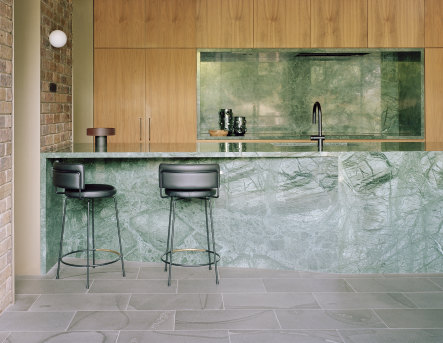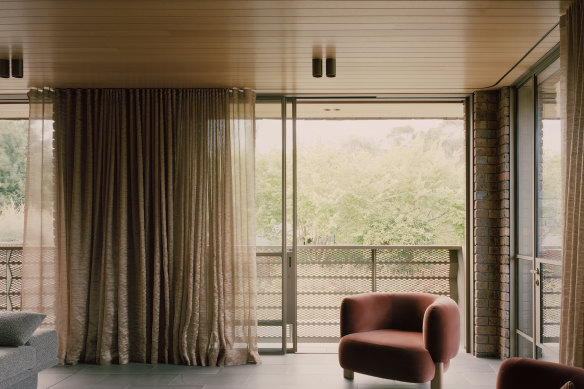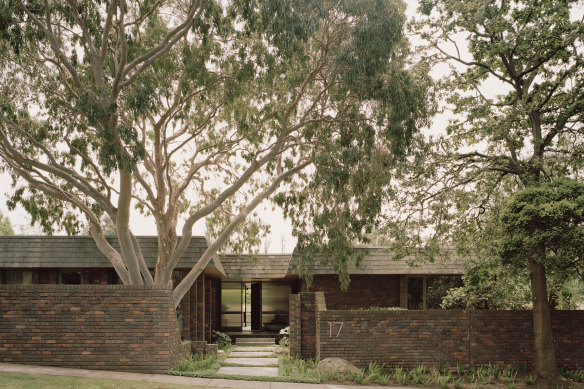This was published 7 months ago
Far from groovy: How did this 70s house win a top architecture award?
The 1970s created some great house trends. Think of sunken lounges — often referred to as “conversation pits” — indoor gardens, exposed timber ceilings, built-in bespoke joinery, and vast open plan entertaining areas.
Top-end homes from this period sometimes came with a cabana or a kidney-shaped swimming pool, but a brown brick house in East Kew that won the prestigious John and Phyllis Murphy Award for Residential Architecture had none of the above.

Mansard House was redesigned by Studio Bright.Credit:
Featuring a mansard-style roof and a carport, also with a mansard roof (added by former owners to create a “seamless” yet pastiche effect), there was nothing endearing about the villa, even for an architecture writer who is smitten with this period and its icons — think architects Holgar & Holgar and Theodore Berman.
For the Kew home’s owners, a couple of empty nesters who had lived in this sprawling house on a large plot with their family, it was a case of renovate or start afresh.
For architect Mel Bright and her team from Studio Bright, there were options for both.
“It certainly wasn’t the type of house you would fall in love with. But as we got into the project, we started to ‘lean into it’,” says Bright, director of the practice whose work on the house received the prestigious John and Phyllis Murphy Award for Residential Architecture from the Australian Institute of Architects (Victorian Chapter) in the category of alterations and additions.

The home’s northern wing was opened up, with a sitting area at one end.Credit:
While many couldn’t reimagine what could be achieved given the 1980s kitchen, the warren of rooms and the lack of connection to the garden, Bright saw the 350-square-metre house spread over two levels as being considerably more.
“To be honest, I never saw it becoming an award-winning home but I could see how areas such as the kitchen and living areas could be opened up to the north with views over the reserve,” says Bright, who noticed in the former arrangement that the couple spent most of their time in a small portion of the house, adjacent to the kitchen, that offered the best light and aspect.
The home’s northern wing was opened up, with a sitting area at one end that’s loosely divided from the dining area by means of a bespoke joinery unit designed by the practice.
Evocative of the 1970s but certainly not trying to imitate the period, this unit allows sight lines from the sitting room through to the kitchen and living area beyond. While the finishes and materials appear to be original, Studio Bright relined the timber ceilings, added new bluestone floors to replace the damaged slate, and reconfigured the window and door apertures to allow for greater insulation and access to a larger terrace.
When it came to the kitchen, there’s now a green marble island bench and splashback combined with wall-to-wall timber joinery. “From the outset, we wanted to unlock the ‘DNA’ of the house and work out what it wanted to be rather than us imposing on it,” says Bright, who could see the place revealing itself with every strategic move. “We were fortunate that all the internal brick walls were still original and not, like many from this period, covered in plaster,” she adds.
Although the house originally comprised four bedrooms, some of these have been reworked to include a home office and spaces such as a sewing room.
And given the purpose was to create a “forever” house, Studio Bright inserted new stairs (the old ones were dodgy) and a lift. The home’s exterior was also thoughtfully reworked with a new perforated concertinaed aluminium balustrade that extends from the terrace to the carport – a contemporary nod that creates privacy, allows for sunlight to permeate and doubles as a frame for the garden bed by landscape designer Sam Eagan.

A portion of the brick fence has been tapered to allow the beauty of an established gum tree to be fully expressed.Credit:
While the home’s high front brick fence remains, as well as the original entry sequence through the generous porch, a portion of the brick fence has been tapered to allow the beauty of an established gum tree to be fully expressed.
“The project felt like we were unpicking a jumper, taking the threads apart, but ever so carefully, allowing the house to breathe in the process,” says Bright.
The Market Recap newsletter is a wrap of the day’s trading. Get it each weekday afternoon.